The seaman was a shock at first. I’d stepped through the bulkhead door and into a dim interior passageway on board the Aranui 5 cruise ship. When my eyes finally adjusted from the brilliant sunshine outside, I found myself staring into the face of a sailor who was covered from head to foot with Polynesian tattoos. After my initial shock, I gathered my wits and asked permission to take his photo. He stared back, perhaps as curious about me as I was about him, but then nodded once. Over the next two weeks, I would learn that tattoos in the Marquesas Islands of French Polynesia are not only accepted but cherished.

Polynesian Tattoos were being applied at least as far back at Neolithic times. The mummified body of Ötzi the Iceman, discovered on the border between Italy and Austria in 1991, has been dated to between 3370 and 3100 B.C. The Iceman had 61 tattoos. Over the centuries, tattooing has been practiced for a variety of spiritual and protective purposes, but perhaps nowhere has it been more strongly ingrained than in the culture of the Marquesas Islands.

During his first landing in Tahiti, Captain James Cook was fascinated by the tattoos that covered the bodies of the indigenous Polynesians. In the ship’s log, he wrote, “Both sexes paint their Bodys, Tattow, as it is called in their Language. This is done by inlaying the Colour of Black under their skins, in such a manner as to be indelible…This method of Tattowing I shall now describe…As this is a painful operation, especially the Tattowing of their Buttocks, it is performed but once in their Lifetimes.”
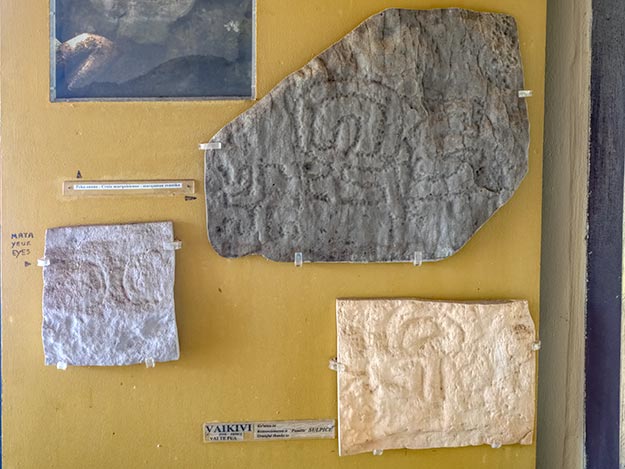
I learned about “tatouage,” as it is called locally, from Teiki Huukena, an expert on the history and meaning of tattoos in the Marquesas Islands. During our voyage around French Polynesia, Teiki conducted three lectures on the subject. Understanding the practice of tattooing required knowing the old stories, which are based in Marquesan Cosmological beliefs. Teiki explained that early Polynesians worshiped Tiki, the first man on earth. The earliest representations of Tiki – simple, stylized stick figurines – were petroglyphs carved into granite boulders. These were often accompanied by designs that represented parts of Tiki, such as his eyes.

Other symbols represented the cosmos. Marquesans saw the world as a sphere because the night sky seemed like a dome covered in stars. Their three most important motifs relate to Tiki and his place within the cosmos. The first, Ipu Ani, is the sphere of the celestial vault, within which Tiki is found. The stars (his eyes) incorporate the spirit of the ancestor. Second, Kake or Kaake, is Ipu Ani cut in half, which represents the spirit of a deceased person returning to the stars. And finally there is Mata Hoata. Its shimmering eyes represent the third day of the moon, considered to be the best day to start planting and for fishing. The nose of Mata Hoata represents the vagina, as Mata Hoata is also the wife of Tiki. Thus this symbol is used to summon fertility and abundance through the gods.
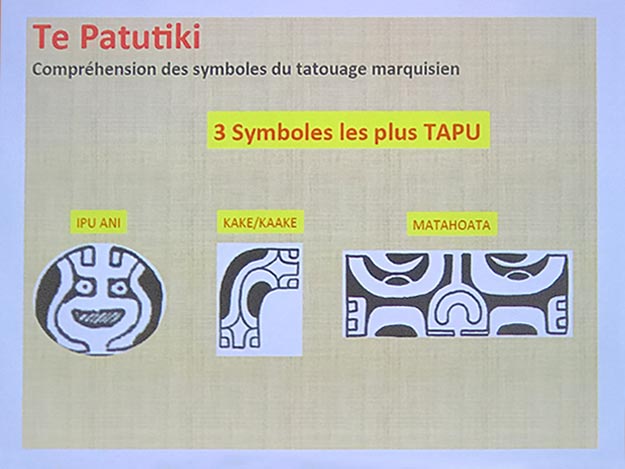
As their culture evolved, Marquesans began sculpting wood and bone into more complex images of Tiki. Eventually, they discovered how to tattoo Tiki onto their bodies. Ink was produced by burning the Ama nut, grinding it into a powder, and mixing it with sterile coconut water. Holes hollowed out of boulders to hold the ink are still visible today. Tattoo artists used a tattooing comb or handmade needle, often made of shark’s teeth. The comb or needle was dipped into the ink and then tapped into the skin. The pain must have been horrible, and without the benefit of antibiotics, infections were common and sometimes fatal. But the end result was worth the suffering, as the tattoos provided protection, fertility, and ensured a good life.
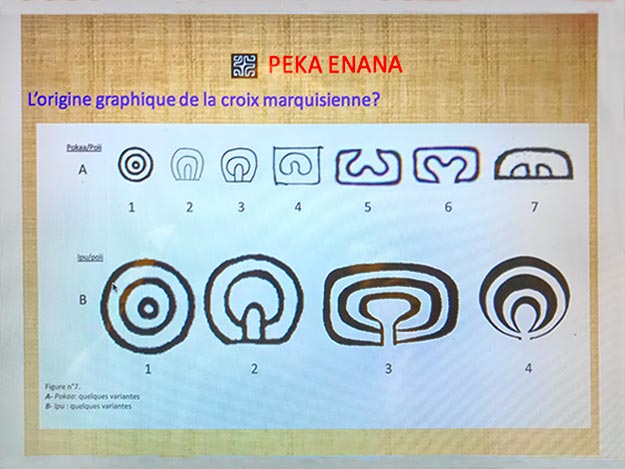
In addition to their protective and spiritual purposes, Polynesian tattoos were given to commemorate an event. Boys received their first tattoo when they reached the age of maturity, at around 14-15 years of age, while girls received a tattoo when they got their first period. Warriors were completely tattooed from head to foot with protective symbols. Each time a warrior accomplished something, he would get another tattoo as an offering of blood to the gods.
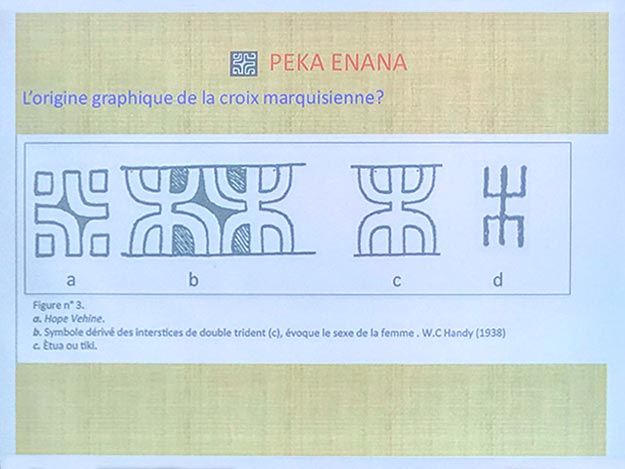
Women had protective symbols tattooed on their hands because they prepared the food for the family. Most important for women was the Marquesan Cross, a design which emerges in the space between two side-by-side Tikis. This powerful emblem was tattooed just below a woman’s ear, which represented the womb. Pregnant women especially revered the cross, as they believed it kept bad spirits from entering the body. These days the Marquesan Cross design adorns almost everything – church altars, fences, canoe paddles, clothing, as well as most Tiki carvings – and is still seen as a powerful protective symbol.
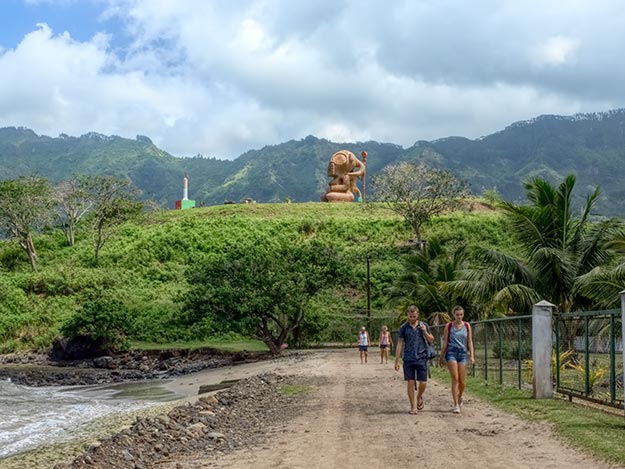
Tattooing almost disappeared from the Marquesas Islands after Catholic missionaries banned it in 1838. Not only did the Bishops consider it to be pagan worship, they also believed that tattooing caused illness. In reality, the decimation of the Marquesan population during the 19th and 20th centuries was caused by diseases like syphilis and smallpox, which were brought to the islands by Europeans. Between 1774 and 1920, the Marquesan population dwindled from 75,000 to a mere 2,000. Fortunately, a French doctor, Louis Rollin, helped turn this around by instituting proper health measures and the prohibitions against tattooing were eventually reversed.

Though modern tattoos in the Marquesas still use many of the ancient symbols and designs, they are said to be more decorative than protective. However, I couldn’t help wondering how accurate this was. I saw tattooed men and women on each of the six inhabited islands in the Marquesas, many of whom sported whole-body coverage. And I couldn’t get that seaman out of my mind. I simply can’t imagine enduring that kind of pain for decorative purposes only. I suspect there will always be a deeply spiritual aspect to the art of tattooing in Polynesia.
Disclosure: I was a guest of Aranui during my French Polynesia cruise. However, the receipt and acceptance of complimentary items or services will never influence the content, topics, or posts in this blog. I write the truth, the whole truth, and nothing but the truth. The Aranui 5 cruise is undoubtedly the best way to experience French Polynesia, a truly remarkable part of the world.

I spent some time in FP, and even have a few motifs on my legs. There was a story of a women that would bring tattoo guns and other equipment to the people of Polynesia to revitalize the tattooing tradition. I believe this would have been in the 60s & 70s, but I can find nothing on it. Would you know what I am referring to?
Sorry Quinn, but I haven’t heard anything like that.
What is Ama Nut?
Hi Mario: Ama is a variety of nut that is indigenous to lands located in the Indian and Pacific oceans. The shells were ground to make the ink for tattoos.
I like that army helmet! Tatted up sailors, see em everyday. Though I’ve only sailed with a few guys from the islands and most didn’t have the full face tattoo’s. Most tatted guy I’ve seen was a Kiwi (Maori).
Hi Butch: The Maoris are part of the wider Polynesian family, and they likely migrated from French Polynesia, Samoa, and Tonga, so it’s not surprising they also have such tattoos.